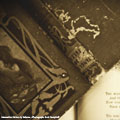Tea and Toast — 3 of 31
Maria del Pangolin
Section - The Kettle
The description of the kettle is "A tall metal cylinder with a button in the handle[if the kettle is switched on], pressed in and lit up blue[otherwise], not pressed in at the moment[end if][first time]. It stretches your reflection out into a horse-faced old schoolmarm. At least, that's how you look when you're making your horse-faced old schoolmarm face[only][if the steam is on-stage]. Steam rushes from its spout[end if]."
Understand "button" or "cylinder" or "metal" or "spout" as the kettle.
The reflection is part of the kettle. It is insignificant. The description of the reflection is "Maybe it looks a bit more like George on the cover of Rubber Soul, with shorter hair."
Before doing anything other than examining when the current action involves the reflection: say "[take no time]It's just a reflection." instead.
Instead of pushing the kettle: try switching on the kettle.
The examine devices rule is not listed in any rulebook. [The kettle is the only device and its description tells you whether it's switched on.]
Before inserting something into the kettle when the noun is not a liquid: say "You could try filling the kettle with water, but it won't really hold anything that isn't a liquid." instead.
Before inserting the strainer into the kettle when the noun is not a liquid: say "[take no time]You almost put the strainer into the kettle before remembering that goes into the teapot instead." instead. [This tricks me, it tricks my testers, better catch it. The "when the noun is not a liquid" clause is just there to get it before the other rule in the "Before" rulebook. This is the sort of thing you do when you're short of sleep.]
Check switching on the unplugged kettle: say "The kettle isn't plugged in." instead.
Check switching on the kettle when the kettle is not filled with something: say "The kettle's button won't stay depressed when the kettle isn't filled with water." instead.
Check switching on the kettle when the kettle is filled with hot water: say "The kettle immediately switches itself back off. The water must have boiled already." instead.
After taking the kettle when the kettle was on the countertop: say "You lift the kettle from its [if the kettle is plugged-in]plugged-in [end if]base."
The base is insignificant scenery on the countertop. The description of the base is "The base of the kettle plugs in to the wall and heats up the kettle itself. You almost never have to deal with it by itself; it just fades into the scenery until something draws your attention to it."
Instead of plugging the base into something: try plugging the kettle into the second noun.
Before putting the kettle on the base: try putting the kettle on the countertop instead.
After putting the kettle on the countertop: say "You put the kettle back on its base."
The steam is scenery. The description of the steam is "Steam rushes from the kettle's spout."
Carry out switching on the kettle:
The kettle steams in four minutes from now;
The kettle boils in six minutes from now.
At the time when the kettle steams:
say "Steam begins to pour from the mouth of the kettle. It'll be boiling in a couple of minutes.";
now the steam is in the kitchen.
At the time when the kettle boils:
say "The kettle switches itself off; the water must have boiled.";
empty cold water from the kettle;
fill the kettle with hot water;
now the kettle is switched off;
remove the steam from play.
